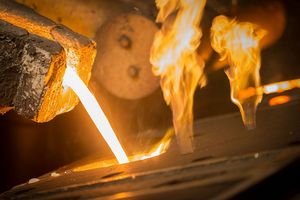HEUNISCH participates in a research project on the efficient use of foundry dust

Through the efficient use of foundry dust, it should be possible to make even better use of resources in the metal industry. The kick-off event for the ForCYCLE II project network took place on 6 November 2019 in the Max Joseph Hall at the Munich Residence. The project network is financed by the Bavarian State Ministry of the Environment and Consumer Protection and stands for improved resource efficiency in the Bavarian economy, particularly in SMEs and trades. Within this framework, a total of eleven projects with an average duration of three years have been worked on since the middle of 2019. The aim is to develop innovative technologies and processes for recycling and the efficient use of resources.
The “securing and preservation of raw materials through the processing and use of foundry dust – Bavarian consortium for recovery of foundry dust metal” subproject is being worked on by the University of Augsburg together with the bifa environmental institute. Several Bavarian foundries are involved in the project: Franken Guss GmbH & Co. KG, Gießerei HEUNISCH GmbH, Kemptner Eisengießerei Adam Hönig AG and Trompetter Guss GmbH Co. KG. The SMEs AKW Apparate+Verfahren GmbH and GPS SIC Keßl GmbH u. Co. KG are also involved in the project.
As in other branches of industry, more environmentally-friendly production is a key component in the Bavarian foundries’ business strategy. The recyclable materials in the dusts are currently lost to landfilling. Since costs are continuing to rise, the processing and subsequent use of the dusts is practical both from an ecological and an economic standpoint. The properties of the dusts are pivotal for their possible use. This includes both the chemical composition (main component content and trace element content) and the physical properties (bulk density and particle size). For many dusts which are separated out during exhaust air purification in foundries, the recycling options aren’t there or are insufficient despite high proportions of materials which contain recyclable substances. Added to this is the fact that the particle size of the filter dusts is generally in a range of between 0.063 mm and <0.250 mm. This makes handling and processing significantly more difficult.
Furthermore, possible adjustments for the reduction of waste levels should be taken into consideration in the project. Alongside appropriate collection and supply logistics, suitable preparation and extraction processes must be available. Since this has only been the case to some (limited) extent to date, further development efforts are also needed here.
The aim of the project is to work together with the foundries to develop practical ways to allow for reclamation and possible reuse of the foundry dusts which occur. Economical alternatives to the present disposal should thus be developed and the recyclable materials contained in the residual material, such as iron and tin, should be made available for recycling.
Source: bifa-aktuell 4.2019



